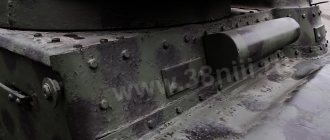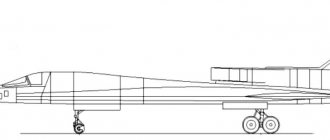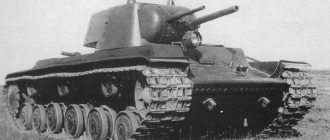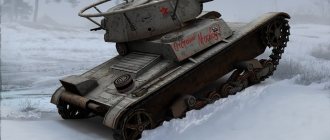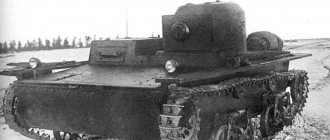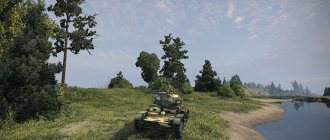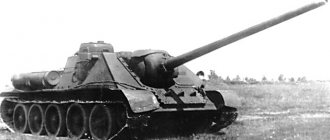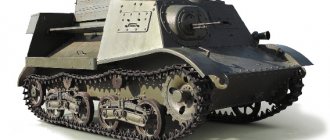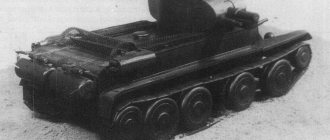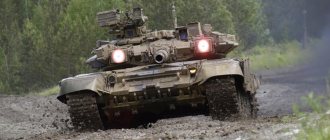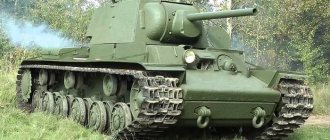BA-10 is the best cannon armored vehicle of the Red Army during the Great Patriotic War, the design of which embodied all the experience accumulated by the engineers of the Izhora plant during the pre-war decade. Like the previous BA-6 vehicle, it was created on the chassis of a three-axle GAZ-AAA truck, but the frame of this chassis was shortened by 200 mm in the middle part and trimmed by 400 mm at the rear.
Design
The front non-driving axle was strengthened and equipped with hydraulic shock absorbers, which increased the smoothness of the vehicle and, accordingly, the accuracy of shooting in motion. The headlights and front wheel hubs were covered with armored caps. A central brake was also applied to the transmission, and the ventilation and cooling system of the engine compartment was improved.
The armored hull remained essentially unchanged, and an improved 45-mm tank gun of the 1934 model with 49 rounds of ammunition was placed in the conical turret, made like the BA-6M. The gun was aimed using telescopic and periscopic sights. Like its predecessors, the BA-10 was equipped with removable Overall tracks and rotating spare wheels mounted on the sides of the vehicle to improve cross-country ability. In general, the armored car had fairly good driving characteristics and could overcome inclines of up to 24° and fords up to 0.6 m deep.
Serial production of the BA-10 began in 1938 and by August 1941, 3,311 vehicles of this type had left the plant’s assembly lines. Some of them were equipped with a 71-TK-1 radio station with a whip antenna. Some vehicles were manufactured in a railway version and were designated BA-10zhd. It should be noted that armored vehicles moving on rails on metal bands did not justify themselves, since they did not have any advantages over ordinary armored tires with weapons.
While the first BA-10 armored cars were just being adopted by combat units of the Red Army, the design bureau of the Izhora plant had already modernized the vehicle. The BA-10M armored car featured enhanced armor protection for the front machine gun mount, improved steering, additional external fuel tanks and a new 71-TK-3 radio station. The combat weight of the vehicle increased to 5.36 tons, but its driving characteristics changed slightly.
In the pre-war years, the BA-10 was the most popular medium armored vehicle of the Red Army. These vehicles were in service with the 7.8 and 9th motorized armored brigades, and were also part of the motorized and tank units of the NKVD. In reconnaissance units, they gradually replaced the obsolete BA-3 and BA-6.
In the fall of 1939, BA-10 armored cars took part in the liberation of the western regions of Ukraine and Belarus, and were then used in battles during the “Winter War” with Finland. In the battles of the Great Patriotic War they were used until 1944, and in some units until the very end of the war. For example, in May 1945, a number of BA-10s guarded the headquarters of large military formations of the Red Army.
In combat operations, BA-10 armored vehicles, of course, could not replace tanks. However, when used correctly, they provided good support to the infantry. When the blockade of Leningrad was broken in January 1943 and fierce battles for the Shlisselburg fortress began, success was achieved by a simultaneous attack from both sides by 19 BA-10s, which suppressed enemy firing points and drove the Germans out of their positions.
Without taking into account the cost of cannon and machine gun weapons, a tank periscope (PT-1) of the 1932 model and a TOP telescopic sight, the armor of the radial BA-10M cost 56,046 rubles. 80 kopecks, and linear - 48,946 rubles. 80 kop..
In total, between 1938 and 1941, 3,413 units of armored vehicles BA-10A and BA-10M were produced, making it the most popular Soviet medium armored vehicle.
Modifications
There were two mass modifications:
– BA-10A
– BA-10M - additional gas tanks are located on the wheel shelves; at the stern there is a special shelf for tracks.
In addition, reconnaissance armored tires (BA-10ZhD) were created on the basis of the armored car.
General information about the BA-10 armored car
The 10th model was developed by specialists from the Izhora plant in 1938. She was a follower of BA-6. The new car was based on the GAZ-AAA chassis. To increase cross-country ability, the crew could quickly put track chains on the rear wheels. Overcoming deep unevenness was carried out using spare wheels (one on each side).
The body was assembled from armored sheets using welding. Those elements (outside and inside) for which welding was not used were fastened with special rivets and high-strength bolts. Brackets were used to connect the frame and body. Some specimens on board had communications equipment.
History of the development of BA-10
The journey begins in 1927 with the release of technical documents for the BA-27 armored car. Initially, the AMO-F-15 chassis was used for the base, but then it was replaced with a Ford-AA (the best option in those years). A four-cylinder gasoline engine was installed under the hood. It developed up to 50 horsepower. Cooled by a liquid system.
The main disadvantage of the technology was considered to be weak firepower. The 37-mm cannon showed zero effectiveness when fighting enemy tanks. The maximum firepower was enough to destroy armor up to 12 millimeters thick.
In 1934, the military leadership came to terms with the lack of benefit from the 27th model. In the same year, engineers began developing a new machine - BA-3. The previous armament was replaced with a turret from the T-26 tank. Initial speed and penetration have become better. Thanks to the improved sighting mechanism, the accuracy of fire has increased.
In 1935, the company began producing the GAZ-AAA, as well as assembling the BA-6 armored car. A year later, a modernized version of the “six” appeared, receiving the index “M”. In 1938, the designers came to the optimal option - the BA-10 armored vehicle. The GAZ-AAA chassis was used as the basis, but with a frame shortened by 60 centimeters.
Service and combat use
War with Japan
The BA-10 armored vehicles experienced their baptism of fire during the conflict near the Khalkhin Gol River. By the beginning of fighting in this area, BA-10s made up approximately half of the entire fleet of medium armored cars (203 units). They entered the battle already in the early phase of the conflict. Thus, on June 20-25, the 3rd battalion of the 149th rifle regiment, with the support of a company of armored cars of the 234th armored battalion of the 8th motorized armored brigade and a battery of the 175th artillery regiment, fought with Japanese-Manchu units northeast of Khalkhin Gol in the Khalkhin areas -Sume and Debden-Sume. Moreover, the latter was already on the territory of Manchuria.
In the Debden-Sume area, Soviet troops discovered a Japanese military town, in which there were up to a battalion of Japanese, a Manchu cavalry regiment and two artillery batteries (75-mm field and 37-mm anti-tank guns). A battle ensued, during which the Japanese, sitting on the roofs of the barracks, pinned the infantry of the 149th regiment to the ground with fire.
However, the commander of the armored company went behind enemy lines, placed armored cars and two 76-mm guns at direct fire and began to destroy the Japanese barracks, which soon caught fire. Panic arose in the town, which our infantry took advantage of to exit the battle. The armored car losses amounted to three vehicles: two BA-10s and one BA-3. All these vehicles were hit and left on enemy territory. Another five BA-10s were damaged by enemy artillery fire.
The powerful armament of Soviet armored vehicles allowed them to fight Japanese tanks on almost equal terms. In this regard, the BA-10s from the 9th Motorized Armored Brigade operated most successfully. At 12 noon on July 3, 1939, Soviet search positions on the eastern bank were attacked by units of the 3rd and 4th Japanese tank regiments, which consisted of more than 70 tanks. At the same time, up to 40 Japanese combat vehicles reached the positions of the company of the armored battalion of the 9th motorized armored brigade (12 BA-10), which first began to retreat.
But when the brigade commander, Colonel S. Oleinikov, arrived in time, the company was stopped and “put in a position with an extended turret” (the armored cars stood behind a dune, above which only their turrets were visible). At this point, the Japanese tanks approached a distance of 800 - 1000 m and the armored vehicles opened fire. As a result of the two-hour battle, 9 tanks were shot down and destroyed, while six BA-10 armored vehicles were damaged, but remained in service.
As a result of the battles it became clear:
1. Armored cars are an excellent anti-tank weapon in defense on terrain with half-closed positions.
2. The firing of Japanese tanks with a 57-mm fragmentation grenade (half of the Japanese tanks participating in this attack were Type 89 tanks, armed with a 57-mm Type 90 cannon with a barrel length of 14.9 calibers) at armored cars did not defeat them and did not justify itself .
3. The attack of Japanese tanks without infantry and artillery preparation did not give them any results other than losses in tanks.
4. An armor-piercing 45 mm grenade easily penetrates the 22 mm armor of Japanese tanks.
5. If the infantry is defending with armored cars and there is a possibility of a massive attack by tanks, then it is imperative to prepare some of the armored cars for firing from semi-closed positions.” By July 20, there were 80 BA-10 armored vehicles in units of the 1st Army Group. The total losses of vehicles of this type by the end of the operation amounted to 41 units.
The final documents of the Soviet command noted that the armored cars suffered the greatest losses from anti-tank artillery and “bottlemen” (Japanese soldiers armed with bottles of gasoline) - up to 90%. From bottles of gasoline and hits from anti-tank guns, almost all armored cars burn and cannot be restored after this.
The Great Patriotic War
During the summer campaign of 1941, medium armored vehicles were used very actively, and often, along with reconnaissance, communications and combat security tasks, they were often used for attacks together with infantry and supporting their units directly on the battlefield, which led to unreasonably large losses. However, if used correctly, Soviet armored cars could successfully fight German tanks. Here is one example.
At 5.00 on June 22, 1941, the commander of the tank regiment of the 5th Tank Division of the 3rd Mechanized Corps, Colonel Bogdanov, assigned the task of conducting reconnaissance to a platoon of 6 BA-10 armored vehicles of Senior Lieutenant Surovtsev. The vehicles left the unit's location at 6.25. When approaching the town of L., the platoon commander organized an ambush in the forest, on both sides of the highway. The vehicles are camouflaged in such a way that it was difficult to notice them from a distance of 200 meters.
At 10.00 a platoon of German motorcyclists appeared, who were destroyed by BA-10 fire from a distance of 200–300 m. After 40 minutes, a light tank appeared on the road, moving at high speed. The commander of one of the armored vehicles set it on fire with the first shot from a gun. After 7 minutes, more bottoms of the tank approached the ambush, which were also destroyed by BA-10 fire. Ten minutes later, a column of 15 tanks and motorcyclists approached the place where the destroyed tanks and motorcycles stood.
With their sudden fire, the BA-10 disabled 3 tanks and a large number of motorcycles, which forced the remaining German vehicles to turn back. With the approach to the town of L, the main forces of the 7th Tank Division of the 39th Tank Corps of the Germans, the platoon of Senior Lieutenant Surovtsev retreated to their own. Thus, as a result of a well-organized ambush, 6 BA-10 armored vehicles knocked out and destroyed 6 German tanks and a large number of motorcycles.
However, despite individual cases of successful use, in the first two months of the war most of the medium armored vehicles of the border districts were lost.
Due to the approach of the front directly to the Izhora plant, the production of BA-10 armored vehicles in September 1941 was transferred to the Baltic plant in Leningrad. At this enterprise, several dozen armored cars were produced from the remaining stock of the Izhora plant, which made up for the losses of the BA-10 and played a big role in the defense of Leningrad. They were also actively used in breaking the blockade.
Southern Front, Rostov-on-Don region, early March 1943. On the morning of January 18, 1943, a Separate reconnaissance battalion under the command of L. Legeza moved together with the infantry to attack Shlisselburg. Painted white, 19 BA-10s rushed forward, crushing the snow with wide Overall tracks mounted on the rear wheels. By 10 o'clock in the morning, three guns, several machine guns and over 120 German soldiers were destroyed by armored car fire. By noon the city was taken.
Medium armored vehicles were used in small numbers on the central fronts in the decisive battles of the 1943 campaigns. For example, in the newly formed 5th Guards Tank Army, by March 30, 1943, there were 12 BA-10s in the 38th armored battalion (besides them, the battalion had 7 T-70s and 10 BA-64s) and 17 BA-10s in the 53rd motorized rifle brigade.
By June 10, 1943, when the 5th Guards Tank Army was already part of the Steppe Front, it had only 12 BA-10s in the 38th Armored Battalion. These vehicles were used in battles in the Belgorod direction and near Kharkov in July - August 1943.
On the eve of the Battle of Kursk - July 1, 1943 - there were 8 BA-10 armored vehicles in the tank units of the Voronezh Front - 3 each in the 6th Guards Army and the 6th Tank Corps and 2 in “other parts of the front”
Some examples of medium armored vehicles were in service with the troops until the end of the war in Europe. As a rule, they were used in security companies of the headquarters of fronts and armies, as well as as command vehicles and communications vehicles in some tank and rifle units. For example, as of December 15, 1944, the troops of the 18th Army had only 6 armored vehicles - 5 BA-64 and 1 BA-10. And in units of the 2nd Belorussian Front, by April 14, 1945, there were still 14 cannon armored cars - 1 BA-10 in the 65th Army and 13 in the 19th Army (3 BA-10 and 3 BA-ZM in the 97th company headquarters security, 3 BA-10 in the 132nd and 1 BA-10 in the 40th Guards Rifle Corps).
Column of BA-10 armored cars in 1941, USSR.
BA-10 in the Wehrmacht
In the Wehrmacht, the BA-10 received the designation Panzerspahwagen BA 203. Quite willingly, the Germans operated the BA-10 railway version, since when moving on rails, such a disadvantage of the Soviet vehicle as limited cross-country ability no longer mattered. The German armored train No. 102 (Pz.Sp.Zug.102), for example, in August 1941 had four BA-10 armored vehicles.
Completely burnt BA-10. Ukraine, June 1941
BA-10 in the Finnish Army
During the Winter War, the Finns captured ten BA-10 armored cars. After the start of the so-called Long War (as military operations against the USSR in 1941-1944 are officially called in Finland), their number increased - as of July 1, 1943, the troops had 24 vehicles of this type. In 1943, the armored cars were modernized - they were equipped with Ford V-8 engines with a power of 95 hp. As training vehicles, two BA-10 armored vehicles were used in the Finnish army until 1959. In 1962, one of the decommissioned armored cars was converted into a self-propelled crane and, under the designation BA-10N, was used in the technical center of the tank forces until 1978.
BA-10 armored vehicles in Vyborg at the end of the war
Termination of service
The final chord of the BA-10 was the Soviet-Japanese war of 1945 - many T-26, BT-7 tanks and BA-10 armored vehicles remained in the troops stationed in the Far East. All this equipment was successfully used against the Japanese, and at the end of hostilities it was donated to the Chinese communists, who used it against the troops of Chiang Kai-shek. It was also used during the Korean War.
Design and technical characteristics of BA-10
Specifications:
- Weight - 5,100 kg;
- Length - 4.7 m;
- Width - 2.1 m;
- Height - 2.2 m;
- Capacity - up to 4 people;
- Power unit power - 50 horsepower;
- Highway speed (maximum) - 53 km/h;
- Movement without refueling - 260-300 km.
Body of armored car BA-10
Rolled steel sheets were used to assemble the body. They were connected to each other by welding. The thickness varied depending on the body part:
- The lower part is 4-6 millimeters;
- The main part is 8-9 millimeters;
- The frontal part and turret are 10 millimeters.
The sheets were placed at different angles to improve bullet resistance. Separate protection was installed for fuel tanks.
In the middle part, rectangular doors were placed on each side for loading and unloading the train. Small observation windows were installed on each door. In combat conditions, they were closed with armored shutters with small slits for inspection of the area. The hinges were inside.
The control compartment was located behind the engine compartment. The driver's seat was on the left, the arrow was on the right. The shooter controlled a machine gun mounted in a ball mount. The windshield, intended for the driver, was protected by an armored shutter with a viewing slot.
The combat compartment was located behind the cockpit. Its roof was made lower to reduce the overall height of the BA-10 armored car. The conical tower rotated in a circle. There was a hatch on top that folded forward. It was used to inspect the environment (not in combat conditions) and for landing and disembarking. In military operations, the shooter used small slits protected by armored barriers for viewing.
Armament
Fire at the enemy was carried out using a 45 mm 20K cannon and a 7.62 mm DT machine gun. The vertical guidance of both guns is from -20 to +20 degrees. The shooter was responsible for turning the turret. He used a hand drive. Targeting was carried out using telescopic and periscopic panoramic sights.
Engine compartment
It was located in front of the cabin. Under the hood, engineers installed a gasoline engine with four cylinders of the carburetor type. Volume - 3.28 liters. Cooling was carried out using a liquid system. Power - 50 horsepower at 2.2 thousand rpm. The power provided acceleration to 53 km/h on the highway. A full refueling was enough for 260-300 kilometers (depending on road conditions).
The transmission of the BA-10 armored car had a characteristic structure for that time. Dry clutch with one disc, manual transmission (4+1), range, cardan and final drives and mechanical brake mechanism. Brakes on the front wheels were abandoned. Instead, a central brake in the transmission was introduced into the design.
The hood was made from sheets of rolled steel. To give the technician access to the power unit and other technical components, the hood tilted forward. It was attached to the roof with reinforced hinges. There were also hatches on the sides for quick access to the engine compartment.
The radiator was placed in front of the power plant. A V-shaped armor plate was installed in front of it for protection. It was equipped with movable flaps with which the technician could adjust the air supply. Cooling and ventilation were also aided by slotted blinds located on the sides of the engine compartment.
Hodovka
It consisted of three axles, the wheel formula was 6x4. To strengthen the front beam, hydraulic shock absorbers were installed. Semi-elliptic leaf springs were added to the rear suspension arrangement to increase strength.
GC tires had a size of 6.50-20. The front axle was equipped with single-pitch wheels. For the driving rear axles, dual-slope axles were used. There was also an additional freely rotating axle with spare wheels. It was located at the bottom of the sides of the engine compartment. An additional axle helped overcome various depressions, preventing the car from “sitting” on the bottom. The characteristics were enough to overcome 24-degree slopes.
To improve the off-road patency of the BA-10 armored car, the crew could quickly put track chains on the rear drive axles. The front axle wheels were protected by streamlined fenders. Flat wings were installed on the rear axles. This design solution made it possible to add drawers to the device for storing spare parts and necessary tools.
Other equipment
Headlights were used to travel at night. They were installed in armored casings and secured with brackets. Some examples had a radio on board. Communication between members of the combat personnel was carried out using an intercom. Shielded electrical equipment facilitated uninterrupted communications.
Light armored vehicles 1965–1985
Armored personnel carriers (APCs) only transported infantry to the battlefield, and the infantrymen already “on their feet” attacked. By the mid-1960s. the military decided to increase the power of infantry fire (without taking into account the attached tanks and artillery). This is how a new class of light armored vehicles appeared - armored infantry vehicles (IFVs) with more powerful weapons.
Weapons and ammunition for infantry fighting vehicles take up space, which is why the “passenger capacity” of infantry fighting vehicles is usually less than that of transporters. Due to more powerful weapons and thicker armor, infantry fighting vehicles are usually heavier than armored personnel carriers, which is why they have a tracked propulsion system, although attempts to create wheeled and wheeled-tracked vehicles have been made more than once.
The main difference between an infantry fighting vehicle and an armored personnel carrier is in the tactics of use. An armored infantry vehicle not only delivers infantry to the battlefield, but also accompanies them in the attack, supporting them with fire and tracks. An infantry fighting vehicle can move after attacking tanks, and only then, closer to the enemy defense line, can land troops. The landing is under fire, so the hatches of the infantry fighting vehicle must be such that the landing force can quickly leave the vehicle and take cover in the folds of the terrain.
BMP-1. THE USSR. 1966
The world's first infantry fighting vehicle was the Soviet BMP-1 (1966), the protection of which was relatively weak. But it was light, mobile and even knew how to swim, and at the same time it carried a fairly powerful 73-mm gun, dangerous even for enemy tanks. The crew of the BMP-1 consisted of a vehicle commander, a driver and a gunner; the landing compartment accommodated 8 people, that is, the BMP just housed a motorized infantry squad.
In 1969, the Marder BMP . With the same capacity, it was more than 2 times heavier than the BMP-1, and in terms of firepower it was noticeably inferior to the Soviet vehicle. But the Marder defense was noticeably stronger. Based on the experience of the war in Afghanistan (1979–1989), the BMP-2 . The main difference between this vehicle, which is a ton heavier than its predecessor, is the replacement of the main armament: a 30-mm automatic cannon was installed in the turret.
BMP-2. USSR, 1980
Crossing rivers has always been important for the army, so they tried to make post-war armored personnel carriers and infantry fighting vehicles floating. BMP-1 and BMP-2 were rowed by caterpillar tracks that acted like the paddle wheels of a steamship. Propellers were used to increase speed on the water, but in shallow water they could cling to the bottom. water cannons were used on the BTR-60/70/80 , which sucked water through a hole in the bottom of the vehicle and threw it back. The swivel wheels of the two front axles acted as rudders while afloat. The floating vehicles had a wave-reflector shield in front, and inside there were pumps for pumping out water that had entered the hull.
The American M113 armored personnel carrier, fighting in Vietnam, turned out to be weak in both armor and armament. Several attempts to create an infantry fighting vehicle based on this transporter - with increased armor and installation of guns - did not give a positive result. the M2 Bradley BMP, developed from scratch, entered service only in 1981. It turned out to be heavier than the Soviet one, but lighter than the German BMP - 20 tons. The vehicle's armor was combined - steel and aluminum sheets, separated by an air gap. The armament also turned out to be “average” - a 25-mm cannon and two ATGM launchers. The Bradley's capacity was less than that of its "competitors" - only 6 paratroopers.
BMP "Marder". Germany. 1969
BMP M2 "Bradley". USA. 1981
The infantry fighting vehicle was an expensive weapon, so the bulk of light armored vehicles continued to be cheaper armored personnel carriers. In the USSR, the BTR-70 was developed according to the BTR-60 . It was better protected, but retained the main drawback of its predecessor - two engines. It was assumed that this would improve the survivability of the armored personnel carrier (one engine is damaged, we are driving the other). However, in practice the car turned out to be not very reliable, and the two engines “interfered” with each other. As a result, the next transporter, the BTR-80 , had one powerful diesel engine. In addition, the vehicle received a high side hatch, which made it easier for paratroopers to disembark.
BTR-70. THE USSR. 1972
BTR-80. THE USSR. 1984
BA-10 M
At the end of the 39th year of the last century, the design bureau of the Izhora plant prepared documentation for an improved model, which received the index “M”. The volume of each fuel tank was increased to 54.5 liters. The gas pipelines were protected with armored strips to increase the survivability of the equipment. The armor of the machine gun mount was changed, the rotation mechanism of the turret was improved. The remaining changes are minor. The weight of the car increased by 400 kilograms, but this did not affect the traction performance.
Use of BA-10 in military conflicts
The first practical use occurred in 1939 in the battle of the Khalkin-Gol River. In subsequent years, the equipment was used to liberate Poland and in the war with Finland. The bulk of the copies were used until 1944. In some units, middle-class armored cars were used until the end of the Second World War. In some cases, the BA-10 armored car was used not only for reconnaissance and security, but also to fight enemy tank detachments.
In 1940, the Finns captured several copies, which they later used to solve their own combat missions. Finnish engineers replaced Soviet power plants with eight-cylinder Ford engines. They developed up to 85 horsepower. Three cars were sold to the Swedish army. German soldiers also captured several models, which were later used by some infantry units, military police and educational institutions.
Polish campaign of the Red Army
In September 1939, BA-10s were actively used during the Polish campaign of the Red Army and took part in military clashes with both Polish and German troops. Thus, on September 18, 1939, in a battle near the town of Dombrov, BA-10s, in a joint attack with light tanks, defeated a column of Polish troops. At the same time, the Poles' losses amounted to 300 people killed and 500 prisoners, as well as one tank destroyed by a BA-10. One of the most difficult operations was the fighting in Grodno, where the Red Army faced organized defenses, and during clashes on the narrow streets of the city, armored vehicles turned out to be very vulnerable to enemy infantry.
What can be concluded?
The BA-10 armored vehicle proved useful for the Soviet army during the Great Patriotic War. Transport served as the basis for the development of future generations of armored vehicles of the middle and light classes.
Of the 3.5 thousand assembled vehicles, according to official data, four survived. They can be found in a tank museum in Finland, in Ukraine in the Poltava region at the site of the death of M. P. Kirponos, in a private collection in the Moscow region and in the “Military Glory of the Urals” museum in Verkhnyaya Pyshma.
